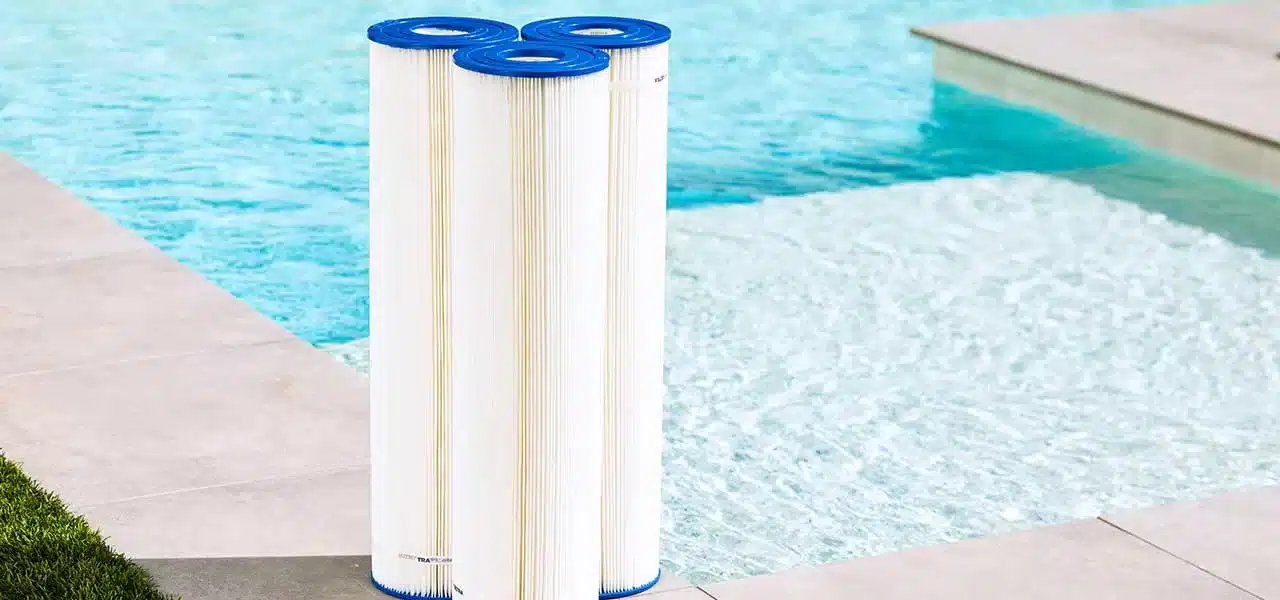FREE Standard Shipping On All Orders $100 or More!*

Pool Filter Cartridges: When to Clean and When to Replace
Proper cleaning of your filter cartridges will not only help keep your pool as clean as possible, but also increase its useful life. You will eventually need to replace the cartridges. Dirt, oils, and minerals build up which cleaning won't remove. Here are some tips for how to clean a pool filter cartridge, and when to replace your pool filter cartridge.
When to Clean a Pool Filter Cartridge
Filter cartridges should be cleaned whenever the filter pressure gauge increases by about 8 PSI (pounds per square inch) or more above the normal operating pressure, or at least every 6 months assuming your filter is properly sized and you haven’t had any unusually large burden placed on the filter (such as a bad algae bloom or very heavy bather loads). If you notice a change in your water quality, inspect the filter for damage or tears, and consider cleaning it.
How to Clean a Pool Filter Cartridge
To properly clean a cartridge, you’ll want to first remove any large dirt and debris, and then soak it in a pool filter cartridge cleaning solution to remove built up oils and scum.
Use a garden hose to remove the larger debris, cleaning between the pleats from top to bottom. The more deeply you clean your pool filter cartridge, the longer it will last. It is not recommended to quickly hose off the cartridge and put it back in the tank. When you clean your cartridges, give it the full treatment each time.
The pool filter wand is a brush that you connect to your garden hose to increase water pressure. This allows you to easily brush the cartridge and have water flow through at the same time.
The Filter Flosser is a high pressure cleaning head that you attach to a garden hose to blast dirt and debris out of the pleats in your filter cartridge.
Once you’ve removed all of the loose debris, soaking the filter in a filter cleaning solution to remove oils and minerals is the next step. Natural Chemistry’s Filter Perfect or In The Swim’s granular filter cleaner are great options.
Natural Chemistry’s Filter Perfect is a highly concentrated, natural enzyme cleaning solution. Add 1 liter of Filter Perfect to a bucket of 5 to 10 gallons of water and soak the cartridge for a minimum of 6 hours, or let it soak overnight. Remove the cartridge from the solution and rinse thoroughly.
In The Swim's granular filter cleaner has similar dosing instructions, add 1 lb. of the granular filter cleaner to 5 gallons of water; soak for 24 hours, then rinse thoroughly.
They both work well on oils and minerals, but - if your cartridge is clogged with oily residues, use the Filter Perfect, and if you have more of a hard water minerals or metal deposits clogging your cartridge, use our Filter Cleaner product.
Helpful Tips
- For best results, allow your cartridge to dry fully after soaking before placing it back in the filter tank.
- You can use a tall kitchen trashcan if it's tall enough; if it's not, flip it over after 6 hours to soak both ends of the filter cartridge.
- Having replacement cartridges allows you to switch cartridges at cleaning time, so you aren't without filtering during the cleaning and drying process.
When to Replace a Filter Cartridge

Generally, most people replace their filter cartridges about every 3-5 years, but don't use the amount of time that has passed as the only determining factor. Monitor the performance of your filter. Your timeframe may be longer or shorter depending on the demand placed on the cartridge.
You can determine when to replace your filter cartridge in three ways.
Cleaning Frequency
Pool filter cartridges need to be cleaned when the pressure gauge rises 8 PSI above normal operating pressure. When the time frame between the significant shortening of this increase in pressure begins, it probably indicates the need to replace the filter cartridge.
Keep track of the filter pressure and the date you clean your filter cartridge. When the length of time between cleanings is half of what it used to be, your filter cartridge has reached it's "half-life", and it's time to replace.
Water Quality

Another way to determine if your filter cartridge needs replacing is if the water stays cloudy or green despite proper chemical balance. In addition, if you have to run your filter longer or use more sanitizer to achieve clean and clear pool water, then that's a clear sign that your cartridge isn't optimally working.
Clean the cartridge first, but if the problem doesn’t clear up in a few days, the cartridge is probably unable to filter the water as effectively as it once did. Each time you clean a cartridge, the fibers separate more, allowing fine dirt and algae to pass through unfiltered. Unicel recommends a new filter cartridge after 12-15 cleanings.
Filter Damage
The third way of determining the need for a new filter cartridge is to inspect it thoroughly every time you clean it, looking for rips or tears in the fabric. Damage to the filter will reduce the potential for sufficient filtering. Replace the cartridge if there are tears or rips in the fabric or if cracks appear in the rubber end cap.
Bigger cartridge filters have longer filter cycles and fewer cleanings per year, and in many cases, requiring only a single cleaning at closing time. Simply put, larger filters will last longer than undersized filters, so go big!
If you have a typically sized cartridge pool filter with 100 square feet of filter surface area per 10000 gallons, your filters should last 2-3 years. If you have double the filter size, you can get nearly double the cartridge lifespan.
In The Swim carries hundreds of replacement pool cartridges. Our filter cartridge search tool allows you to quickly find your cartridge by part number, size or filter manufacturer. All you need to find a replacement cartridge on our site is the part number and/or the dimensions (length and width).